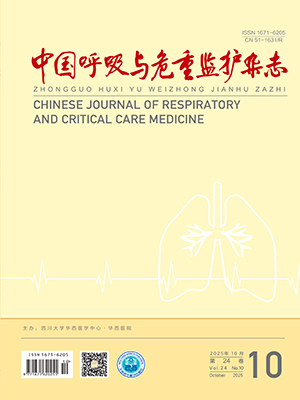| 1. |
Slutsky AS, Ranieri VM. Ventilator-induced lung injury. N Engl J Med, 2013, 369(22): 2126-2136.
|
| 2. |
Gattinoni L, Carlesso E, Cressoni M. Selecting the 'right' positive end-expiratory pressure level. Curr Opin Crit Care, 2015, 21(1): 50-57.
|
| 3. |
Fan E, Brodie D, Slutsky AS. acute respiratory distress syndrome: advances in diagnosis and treatment. JAMA, 2018, 319(7): 698-710.
|
| 4. |
Walkey AJ, Del Sorbo L, Hodgson CL, et al. Higher PEEP versus lower PEEP strategies for patients with acute respiratory distress syndrome. A systematic review and meta-analysis. Ann Am Thorac Soc, 2017, 14(Suppl 4): S297-S303.
|
| 5. |
Santa Cruz R, Rojas JI, Nervi R, et al. High versus low positive end-expiratory pressure (PEEP) levels for mechanically ventilated adult patients with acute lung injury and acute respiratory distress syndrome. Cochrane Database Syst Rev, 2013, 6(6): CD009098.
|
| 6. |
Gattinoni L, Tonetti T, Quintel M. Regional physiology of ARDS. Crit Care, 2017, 21(Suppl 3): 312.
|
| 7. |
Mauri T, Yoshida T, Bellani G, et al. Esophageal and transpulmonary pressure in the clinical setting: meaning, usefulness and perspectives. Intensive Care Med, 2016, 42(9): 1360-1373.
|
| 8. |
Cressoni M, Chiumello D, Algieri I, et al. Opening pressures and atelectrauma in acute respiratory distress syndrome. Intensive Care Med, 2017, 43(5): 603-611.
|
| 9. |
Chiumello D, Carlesso E, Cadringher P, et al. Lung stress and strain during mechanical ventilation for acute respiratory distress syndrome. Am J Respir Crit Care Med, 2008, 178(4): 346-355.
|
| 10. |
Akoumianaki E, Maggiore SM, Valenza F, et al. The application of esophageal pressure measurement in patients with respiratory failure. Am J Respir Crit Care Med, 2014, 189(5): 520-531.
|
| 11. |
Protti A, Cressoni M, Santini A, et al. Lung stress and strain during mechanical ventilation: any safe threshold?. Am J Respir Crit Care Med, 2011, 183(10): 1354-1462.
|
| 12. |
Yoshida T, Brochard L. Esophageal pressure monitoring: why, when and how. Curr Opin Crit Care, 2018, 24(3): 216-222.
|
| 13. |
Brochard L. Measurement of esophageal pressure at bedside: pros and cons. Curr Opin Crit Care, 2014, 20(1): 39-46.
|
| 14. |
Talmor D, Sarge T, O'Donnell CR, et al. Esophageal and transpulmonary pressures in acute respiratory failure. Crit Care Med, 2006, 34(5): 1389-1394.
|
| 15. |
Washko GR, O'Donnell CR, Loring SH. Volume-related and volume-independent effects of posture on esophageal and transpulmonary pressures in healthy subjects. J Appl Physiol (1985), 2006, 100(3): 753-758.
|
| 16. |
Loring SH, O'Donnell CR, Behazin N, et al. Esophageal pressures in acute lung injury: do they represent artifact or useful information about transpulmonary pressure, chest wall mechanics, and lung stress?. J Appl Physiol (1985), 2010, 108(3): 515-522.
|
| 17. |
Talmor D, Sarge T, Malhotra A, et al. Mechanical ventilation guided by esophageal pressure in acute lung injury. N Engl J Med, 2008, 359(20): 2095-2104.
|
| 18. |
Acute Respiratory Distress Syndrome Network. Ventilation with lower tidal volumes as compared with traditional tidal volumes for acute lung injury and the acute respiratory distress syndrome. N Engl J Med, 2000, 342(18): 1301-1308.
|
| 19. |
Fish E, Novack V, Banner-Goodspeed VM, et al. The Esophageal Pressure-Guided Ventilation 2 (EPVent2) trial protocol: a multicentre, randomised clinical trial of mechanical ventilation guided by transpulmonary pressure. BMJ Open, 2014, 4(9): e006356.
|
| 20. |
Pelosi P, Goldner M, McKibben A, et al. Recruitment and derecruitment during acute respiratory failure: an experimental study. Am J Respir Crit Care Med, 2001, 164(1): 122-1230.
|
| 21. |
Gattinoni L, Chiumello D, Carlesso E, et al. Bench-to-bedside review: chest wall elastance in acute lung injury/acute respiratory distress syndrome patients. Crit Care, 2004, 8(5): 350-355.
|
| 22. |
Staffieri F, Stripoli T, De Monte V, et al. Physiological effects of an open lung ventilatory strategy titrated on elastance-derived end-inspiratory transpulmonary pressure: study in a pig model. Crit Care Med, 2012, 40(7): 2124-2131.
|
| 23. |
Grasso S, Terragni P, Birocco A, et al. ECMO criteria for influenza A (H1N1)-associated ARDS: role of transpulmonary pressure. Intensive Care Med, 2012, 38(3): 395-403.
|
| 24. |
Hedenstierna G. Esophageal pressure: benefit and limitations. Minerva Anestesiol, 2012, 78(8): 959-966.
|
| 25. |
Chiumello D, Cressoni M, Colombo A, et al. The assessment of transpulmonary pressure in mechanically ventilated ARDS patients. Intensive Care Med, 2014, 40(11): 1670-1678.
|
| 26. |
Chiumello D, Cressoni M, Carlesso E, et al. Bedside selection of positive end-expiratory pressure in mild, moderate, and severe acute respiratory distress syndrome. Crit Care Med, 2014, 42(2): 252-264.
|
| 27. |
Gulati G, Novero A, Loring SH, et al. Pleural pressure and optimal positive end-expiratory pressure based on esophageal pressure versus chest wall elastance: incompatible results. Crit Care Med, 2013, 41(8): 1951-1957.
|
| 28. |
Banchero N, Schwartz PE, Tsakiris AG, et al. Pleural and esophageal pressures in the upright body position. J Appl Physiol, 1967, 23(2): 228-234.
|
| 29. |
Krebs J, Pelosi P, Tsagogiorgas C, et al. Effects of positive end-expiratory pressure on respiratory function and hemodynamics in patients with acute respiratory failure with and without intra-abdominal hypertension: a pilot study. Crit Care, 2009, 13(5): R160.
|
| 30. |
Kubiak BD, Gatto LA, Jimenez EJ, et al. Plateau and transpulmonary pressure with elevated intra-abdominal pressure or atelectasis. J Surg Res, 2010, 159(1): e17-24.
|




